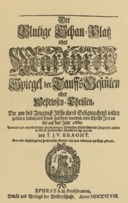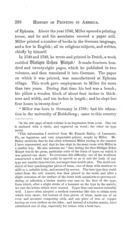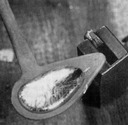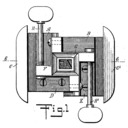A printer who has run out of a particular character is indeed out of sorts. This isn't a joke. A "sort" is the term for a particular character ('A' is a sort, 'B' is a sort, etc.) and the phrase "out of sorts" originates with the unfortunate occurance of printers running out of a particular character. When a job has to be finished without time to acquire more type, being out of sorts leads to lost business and unhappy former customers. It is no surprise, then, that printers have, from some remote period in the history of the art, improvised. It is possible, with materials to be found around an ordinary letterpress printing shop, to duplicate existing types. It isn't efficient, but it can be done. Dr. Franklin may have been the first to write about it (in America, at least), but it is most unlikely that he was the first to do it.
What is surprising is that it is possible to cast a typemetal matrix from a type (made of typemetal) and cast a new (typemetal) type from it.
My thanks to Stephen O. Saxe for suggesting the title of this set of Notebooks. At first I had termed this "Emergency" typecasting, but that suggests a degree of haste not necessarily present. Steve pointed out that this kind of typecasting probably happened all the time in Colonial America. He suggested "improvised" or "makeshift" as alternatives. Both terms would work; I like the sound of "makeshift." It may not do quite enough justice to a relatively sophisticated machine such as the Brimulta Sortsmaster, but even such a machine is substantially simpler than a production type-caster such as a pivotal, Thompson, or Barth. (I've left the URL of this page unchanged, though, so you'll still see "emergency" in it.)
Aside: In some online discussions in the past there has been some confusion between the various methods of duplicating sorts, on the one hand, and the process of "dabbing" (German: "Abklatschen") for reproducing woodcuts, on the other. The two processes are distinct. Stan Nelson posted a clarification of this to the LETPRESS list on 2000-10-17.

Benjamin Franklin
When Franklin was actively printing in America, buying new type meant importing it by sailing ship from England. He writes, therefore, that he was able to improvise a mold and make matrices of clay for the emergency casting of sorts.
The "house of James" in London, where he says that he saw typefounding practiced, would have been the type foundry of Thomas and John James. See Talbot Baines Reed's A History of the Old English Letter Foundries (London: Elliot Stock, 1887): 217-218.
The icon at left links to a PDF of a single page of a digitization by Google of the Harvard University copy of a fairly early edition of The Life of Benjamin Franklin, edited by Mason L. Weems (Philadelphia: M. Carey, 1817).

Peter Miller
Peter Miller established a press in the Ephrata Cloister in Pennsylvania, and in 1748 printed Der Blutige Schauplatz (often commonly known in English as The Martyr's Mirror). Isaiah Thomas (see below) reports that during this printing "particular sorts of the fonts of types on which it was printed ran short" and that one of his (Miller's) workmen "constructed a mold that could be moved so as to suit the body of any type not smaller than brevier [roughly 8 point], nor larger than double pica [about 24 point]." Using this mold, they would first cast a "leaden" [presumably typemetal] matrix and then use that matrix to cast more type as required.
At present the only source of information about this of which I am aware is a footnote in the second edition (1874) of Isaiah Thomas' The History of Printing in America . This footnote also contains Thomas' description of his own makeshift sorts casting practices. Please refer to it for his full account, in context, of Miller's methods.
Caution: Miller's use of aquafortis (nitric acid), while not uncommon in the 18th century, cannot now be recommended. The reaction of nitric acide with lead produces lead(II) nitrate (plumb dulcis, in medieval terms), which is toxic. As Nelson (below) demonstrates, other and safer methods of creating a releasing agent are effective.
The icon for this section is a digitization of a 19th century reproduction of the title page of Der Blutige Schauplatz as printed by Miller in Ephrata in 1748. It is taken from Julius Friedrich Sachse, The German Sectarians of Pennsylvania: 1742-1800 ["A Critical and Legendary History of the Ephrata Cloister and the Dunkers."] (Philadelphia: For the Author, 1900). Vol. II, p. 245. This volume has been digitized by the Princeton Theological Seminary Library from their copy and is available via The Internet Archive at: http://archive.org/details/germans02sach If you click on the icon you'll go to a full-resolution version of this single page (not to any further information on Miller's makeshift typecasting).

Isaiah Thomas
In the first volume of the 1874 second edition of Isaiah Thomas' The History of Printing in America (Albany, NY: Joel Munsell, Printers, 1874) [issued as Vol. V of Archæologica Americana. Transactions and Collections of the American Antiquarian Society ], there is a footnote by Thomas (not present in the first edition) explaining two methods of makeshift typecsting. The first method is that used by Peter Miller (see above) involving a shop-made mold and typemetal matrices. The second is that used by Thomas himself, which involved the use of a composing stick as an improvised mold, along with clay matrices. Franklin had earlier used clay matrices, but Thomas' method is the earliest of which I am presently aware involving a composing stick.
The image at left links to a single page, as a PDF, extracted from the University of Michigan digitization of the first volume of this work, as contributed to The Internet Archive. http://archive.org/details/aey4217.0005.001.umich.edu

Stan Nelson
Saxe, Stephen O. "Following Isaiah Thomas: Casting Sorts in a Composing Stick." The APHA [American Printing History Association] Newsletter. No. 78 (July/August 1987): 1-2. This is an illustrated account by Saxe of Stan Nelson's method of improvised type casting using a (metal) composing stick for most of the mold.
Stan's method is fascinating to me because it shows how I had become caught up in my own assumptions. Were I to try this, I would in some way try to create a typemetal matrix which approximated a conventional hand or machine typecaster's matrix. Stan, on the other hand, creates a matrix which not only duplicates the printing face of the existing type but its nick as well!
The APHA Newsletter No. 78 is copyright 1987 by Stephen O. Saxe and is reprinted here by his kind permission. Please ask his permission first before reproducing it further.

Taylor's Adjustable Type Mold (1910)
Thanks to Sky Shipley ( Skyline Type Foundry) we know more about this machine than we do about most others.

The Turner Apparatus (1923)
A patent from 1923 for a device which may not have entered production.

Typofix Type Caster(1920s)
A German machine from the 1920s. Hand-Typen-Gießapparat "Typofix"

Unicast
This looks very much like a 1950s English version of the Typofix (see above).

Brimulta Sortsmaster (1950s)
AKA '"Brimulta" Type-Caster'. An English caster, made by the Multiple Acting Flux Co. Ltd. of Sheffield (makers of "Brimulta" brand flux) and Ex-Trans-Im Ltd. of London. It is notable because it has an an integral force pump. Patrick Goossens of Belgium has very kindly photographed the machine in his collection.
The APHA Newsletter No. 78 is copyright 1987 by Stephen O. Saxe and is reprinted here by his kind permission. Please ask his permission first before reproducing it further.
The texts of Franklin, Thomas, and Sachse from which extracts are reprinted here are in the public domain, as are their scans by Google. The extracts as reprinted here remain in the public domain.
All portions of this document not noted otherwise are Copyright © 2011-2013 by David M. MacMillan and Rollande Krandall.
Circuitous Root is a Registered Trademark of David M. MacMillan and Rollande Krandall.
This work is licensed under the Creative Commons "Attribution - ShareAlike" license. See http://creativecommons.org/licenses/by-sa/3.0/ for its terms.
Presented originally by Circuitous Root®
Select Resolution: 0 [other resolutions temporarily disabled due to lack of disk space]